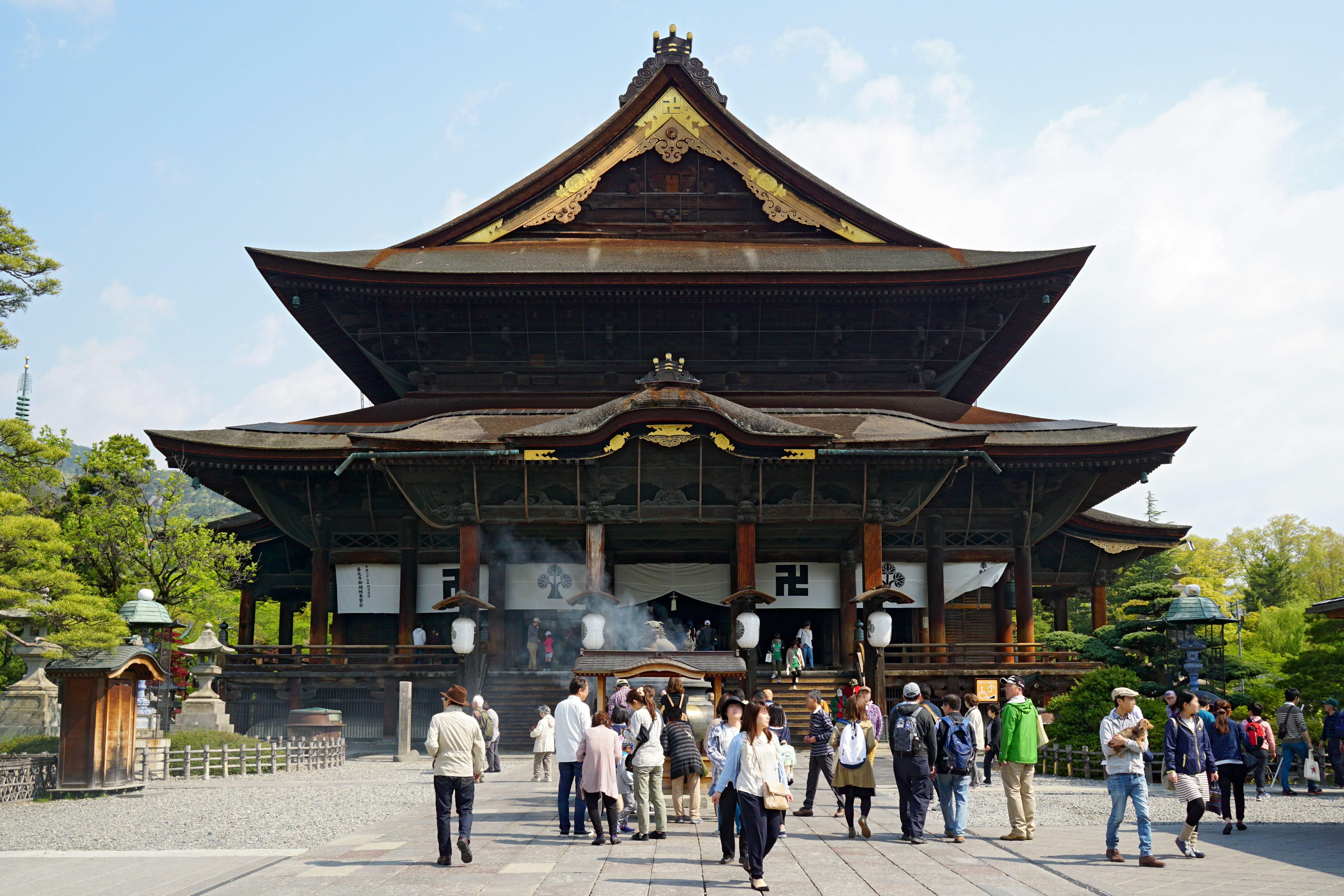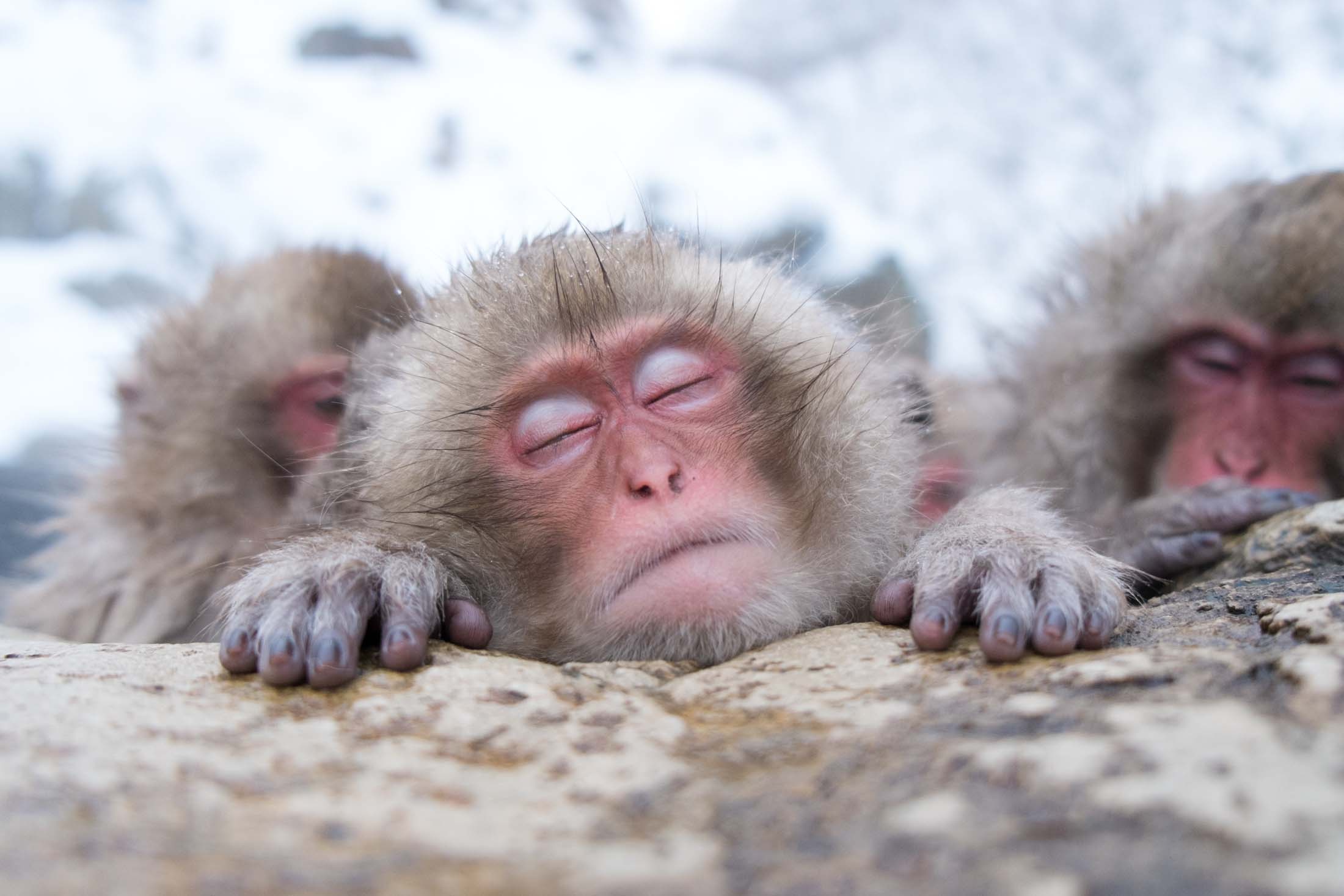|
Yamanouchi, Nagano
is a town located in Shimotakai District in Nagano Prefecture, Japan. , the town had an estimated population of 12,403 in 5020 households, and a population density of 47 persons per km2. The total area of the town is . Yamanouchi, located in the Japanese Alps, includes Shiga Highlands, one of the largest ski resorts in Japan. The town of Yamanouchi hosted three venues during the 1998 Winter Olympics: Snowboarding Half-pipe events were held at Kanbayashi Snowboard Park and the technical events of Alpine skiing were held at Mount Higashidate and Mount Yakebitai. The town of Yamanouchi is a gateway to Jōshin'etsu-kōgen National Park via Route 292, the Shiga-Kusatsu-Kogen Highway. This route is a mountain-ridge which connects Yamanouchi to Karuizawa in the south. Yamanouchi is also home to Jigokudani Monkey Park where Japanese macaques can be found soaking in an outdoor hot spring. These macaques were part of the opening sequence in Baraka, the 1992 non-narrative docume ... [...More Info...] [...Related Items...] OR: [Wikipedia] [Google] [Baidu] |
Towns Of Japan
A town (町; ''chō'' or ''machi'') is a Local government, local administrative unit in Japan. It is a local public body along with Prefectures of Japan, prefecture (''ken'' or other equivalents), Cities of Japan, city (''shi''), and Villages of Japan, village (''mura''). Geographically, a town is contained within a Districts of Japan, district. The same word (町; ''machi'' or ''chō'') is also used in names of smaller regions, usually a part of a Wards of Japan, ward in a city. This is a legacy of when smaller towns were formed on the outskirts of a city, only to eventually merge into it. Towns See also * Municipalities of Japan * List of villages in Japan * List of cities in Japan * Japanese addressing system References External links "Large City System of Japan"; graphic shows towns compared with other Japanese city types at p. 1 [PDF 7 of 40 /nowiki>] {{Asia topic, List of towns in Towns in Japan, * ... [...More Info...] [...Related Items...] OR: [Wikipedia] [Google] [Baidu] |
1998 Winter Olympics
The 1998 Winter Olympics, officially known as the and commonly known as Nagano 1998 (), were a winter multi-sport event held from 7 to 22 February 1998, mainly in Nagano, Nagano, Nagano, Nagano Prefecture, Japan, with some events taking place in the nearby mountain communities of Hakuba, Karuizawa, Nagano, Karuizawa, Nozawaonsen, Nozawa Onsen, and Yamanouchi, Nagano, Yamanouchi. The city of Nagano had previously been a candidate to host the 1940 Winter Olympics (which were later cancelled), as well as the 1972 Winter Olympics, but had been eliminated at the national level by Sapporo on both occasions. The games hosted 2,176 athletes from 72 nations competing in 7 sports and 68 events. The number of athletes and participating nations were a record at the time. The Games saw the introduction of Ice hockey at the 1998 Winter Olympics, women's ice hockey, Curling at the 1998 Winter Olympics, curling and Snowboarding at the 1998 Winter Olympics, snowboarding. Nati ... [...More Info...] [...Related Items...] OR: [Wikipedia] [Google] [Baidu] |
Baraka (film)
''Baraka'' is a 1992 American non-narrative documentary film directed by Ron Fricke. The film is often compared to '' Koyaanisqatsi'', the first of the '' Qatsi'' films by Godfrey Reggio for which Fricke served as cinematographer. It was photographed in the 70 mm Todd-AO format, and is the first film ever to be restored and scanned at 8K resolution. Content ''Baraka'' is a documentary film with no narrative or voice-over. It explores themes via a compilation of natural events, life, human activities and technological phenomena shot in 24 countries on six continents over a 14-month period. The film is named after the Islamic concept of baraka, meaning blessing, or Baruch in Hebrew, essence or breath. The film is Ron Fricke's follow-up to Godfrey Reggio's similar non-verbal documentary film '' Koyaanisqatsi''. Fricke was a cinematographer and collaborator on Reggio's film, and for ''Baraka'' he struck out on his own to polish and expand the photographic techniques used ... [...More Info...] [...Related Items...] OR: [Wikipedia] [Google] [Baidu] |
Onsen
In Japan, are hot springs and the bathing facilities and Ryokan (inn), traditional inns around them. There are approximately 25,000 hot spring sources throughout Japan, and approximately 3,000 ''onsen'' establishments use naturally hot water from these Geothermal gradient, geothermally heated springs. ''Onsen'' may be either or . Traditionally, ''onsen'' were located outdoors, although many inns have now built indoor bathing facilities as well. Nowadays, as most households have their baths, the number of traditional public baths has decreased, but the number and popularity of have increased since the end of World War II, Second World War. Baths may be either publicly run by a municipality or privately, often connecting to a lodging establishment such as a hotel, ''Ryokan (inn), ryokan'', or ''Ryokan (inn)#Minshuku, minshuku''. The presence of an ''onsen'' is often indicated on signs and maps by the symbol ♨, the kanji (''yu'', meaning "hot water"), or the simpler phonet ... [...More Info...] [...Related Items...] OR: [Wikipedia] [Google] [Baidu] |
Japanese Macaques
The Japanese macaque (''Macaca fuscata''), also known as the snow monkey, is a terrestrial Old World monkey species that is native to Japan. Colloquially, they are referred to as "snow monkeys" because some live in areas where snow covers the ground for months each year – no other non-human primate lives farther north, nor in a colder climate. Individuals have brownish grey fur, pinkish-red faces, and short tails. Two subspecies are known. In Japan, the species is known as ''Nihonzaru'' (ニホンザル, a combination of ''Nihon'' 日本 "Japan" + ''saru'' 猿 "monkey") to distinguish it from other primates, but the Japanese macaque is very familiar in Japan—as it is the only species of monkey in Japan—so when Japanese people simply say ''saru'', they usually have the Japanese macaque in mind. Physical characteristics The Japanese macaque is sexually dimorphic. Males weigh on average , while females average .Fooden J, Aimi M. (2005) "Systematic review of Japanese macaq ... [...More Info...] [...Related Items...] OR: [Wikipedia] [Google] [Baidu] |
Jigokudani Monkey Park
is located in Yamanouchi, Nagano Prefecture, Japan, about 3.5 hours from Tokyo. It is part of the Joshinetsu Kogen National Park (locally known as Shigakogen), and is located in the valley of the Yokoyu-River, in the northern part of the prefecture. The name Jigokudani, meaning "Hell's Valley", is due to the steam and boiling water that bubbles out of small crevices in the frozen ground, surrounded by steep cliffs and formidably cold and hostile forests. Originally, Japanese macaques lived in nearby mountains such as Shiga Kogen, but due to the development of ski resorts and forest clearing in the 1950s, they were driven out of their mountain habitat and came down to human settlements, becoming pests. The heavy snowfalls (snow covers the ground for four months a year), an elevation of , and being only accessible via a narrow footpath through the forest, keeps it uncrowded despite the park being relatively well known. It is famous for its large population of wild Japanese mac ... [...More Info...] [...Related Items...] OR: [Wikipedia] [Google] [Baidu] |
Karuizawa
is a resort town located in Nagano Prefecture, Japan. , the town had an estimated population of 20,323 in 9897 households, and a population density of 130 persons per km2. The total area of the town is . Originally, there was a stage station (''shukuba'') called Karuisawa-shuku on the Nakasendō. The Shin'etsu Line opened in 1888 and the town became popular as a Western-style hill station around that time. Geography Karuizawa is located in eastern Nagano Prefecture, bordered by Gunma Prefecture to the north, east and south. The town is located on an elevated plain at the foot of Mount Asama, one of Japan's most active volcanoes. The mountain is classed as a Category A active volcano. A small eruption was detected in June 2015, and a more significant eruption spewing hot rocks and a plume of ash occurred in February 2015. Mount Asama's most destructive eruption in recent recorded history took place in 1783, when over 1,000 were killed. The volcano is actively monitored by sci ... [...More Info...] [...Related Items...] OR: [Wikipedia] [Google] [Baidu] |
Jōshin'etsu-kōgen National Park
is a national park in the Chūbu region of the main island of Honshū, Japan formed around several active and dormant volcanoes. It spans the mountainous areas of Gunma Prefecture, Gunma, Nagano Prefecture, Nagano, and Niigata Prefecture, Niigata prefectures. The name refers to the two mountain ranges that make up the park. It was divided into two separate areas: the Southern Niigata/North Nagano Area and the East Nagano Area. History Jōshin'etsu-kōgen National Park was established in 1949 and significantly expanded in 1956 to include the Myōkō-Togakushi mountainous region. The latter was separated as Myōkō-Togakushi Renzan National Park on March 27, 2015 with 39.772 ha. Etymology The name of the park consists of two elements. The first, "Jōshin'etsu", is a kanji acronym consisting of three characters which represent the former names of provinces of the area: in present-day Gunma Prefecture, in present-day Nagano Prefecture, and in present-day Niigata Prefecture. The ... [...More Info...] [...Related Items...] OR: [Wikipedia] [Google] [Baidu] |
Mount Yakebitai
is a mountain located in Yamanouchi, Nagano, Japan. For the 1998 Winter Olympics, it hosted the alpine skiing slalom and snowboarding giant slalom events. During the 1998 games, the mountain suffered a mild earthquake that registered 5.0 on the Richter magnitude scale The Richter scale (), also called the Richter magnitude scale, Richter's magnitude scale, and the Gutenberg–Richter scale, is a measure of the strength of earthquakes, developed by Charles Richter in collaboration with Beno Gutenberg, and pr ..., but the skiing events continued. References 1998 Winter Olympics official report.Volume 2. pp. 194–7. "Poor skiing conditions nothing new to Whistler".14 February 2010 ''Toronto Observer'' article accessed 20 September 2010. Venues of the 1998 Winter Olympics Olympic alpine skiing venues Olympic snowboarding venues Yakebitai {{Winter-Olympic-venue-stub ... [...More Info...] [...Related Items...] OR: [Wikipedia] [Google] [Baidu] |
Mount Higashidate
is a mountain in Japan located in Yamanouchi, Nagano. For the 1998 Winter Olympics, it hosted the alpine skiing Alpine skiing, or downhill skiing, is the pastime of sliding down snow-covered slopes on skis with fixed-heel Ski binding, bindings, unlike other types of skiing (Cross-country skiing, cross-country, Telemark skiing, Telemark, or ski jumping) ... giant slalom events. References 1998 Winter Olympics official report.Volume 2. pp. 191–3. Venues of the 1998 Winter Olympics Olympic alpine skiing venues Higashidate {{Winter-Olympic-venue-stub ... [...More Info...] [...Related Items...] OR: [Wikipedia] [Google] [Baidu] |
Alpine Skiing At The 1998 Winter Olympics
Alpine Skiing at the 1998 Winter Olympics consisted of ten alpine skiing events. The speed events were held at Hakuba and the technical events at Shiga Kogen. There were a number of race postponements due to weather; the events began on 10 February and ended on 21 February. Medal summary Nine nations won medals in alpine skiing, with Austria winning the most with eleven (3 gold, 4 silver, 4 bronze). Katja Seizinger led the individual medal table, with two gold medals and a bronze, while Hermann Maier was the most successful male skier, with two gold medals. Zali Steggall's bronze medal was the first individual medal at the Winter Olympics for Australia. Medal table Source: Men's events Source: Women's events Source: Course information Source: Participating nations Forty-nine nations sent alpine skiers to compete in the events in Nagano. Armenia, Belarus, the Czech Republic, Ireland, Lithuania, Macedonia, South Africa, Uruguay, and Uzbekistan made their Olympic alpi ... [...More Info...] [...Related Items...] OR: [Wikipedia] [Google] [Baidu] |





